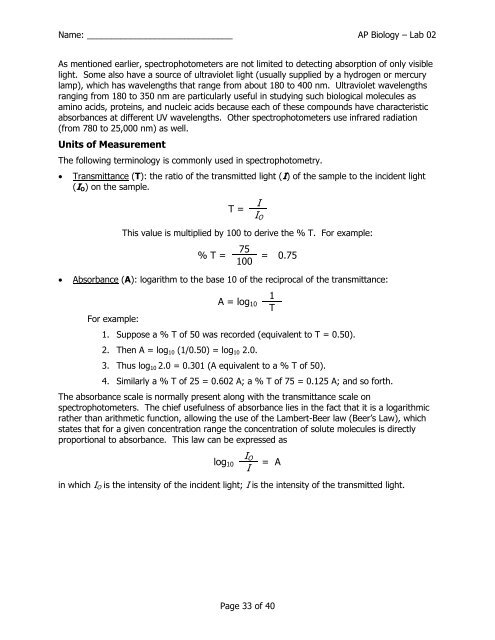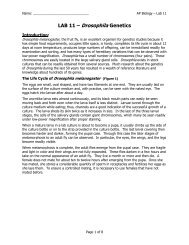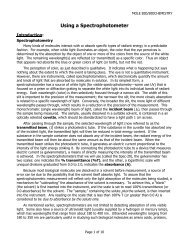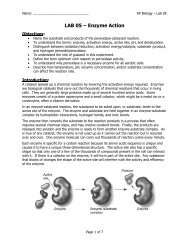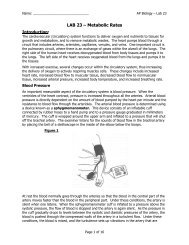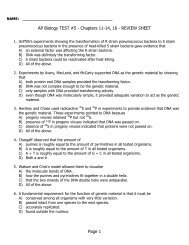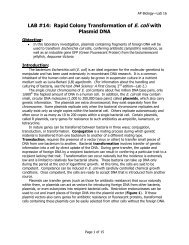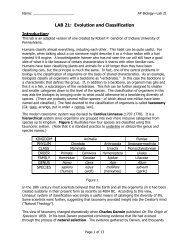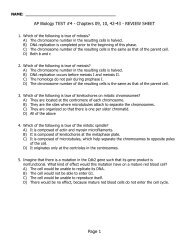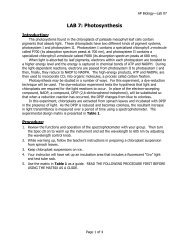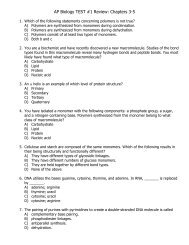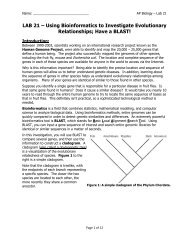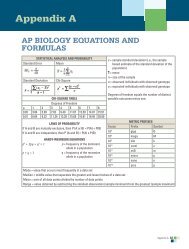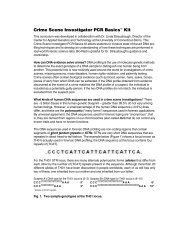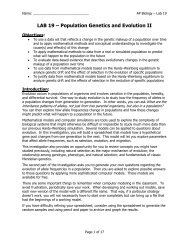AP Lab 02 - Biology Lab Skills
AP Lab 02 - Biology Lab Skills
AP Lab 02 - Biology Lab Skills
Create successful ePaper yourself
Turn your PDF publications into a flip-book with our unique Google optimized e-Paper software.
Name: ______________________________ <strong>AP</strong> <strong>Biology</strong> – <strong>Lab</strong> <strong>02</strong><br />
As mentioned earlier, spectrophotometers are not limited to detecting absorption of only visible<br />
light. Some also have a source of ultraviolet light (usually supplied by a hydrogen or mercury<br />
lamp), which has wavelengths that range from about 180 to 400 nm. Ultraviolet wavelengths<br />
ranging from 180 to 350 nm are particularly useful in studying such biological molecules as<br />
amino acids, proteins, and nucleic acids because each of these compounds have characteristic<br />
absorbances at different UV wavelengths. Other spectrophotometers use infrared radiation<br />
(from 780 to 25,000 nm) as well.<br />
Units of Measurement<br />
The following terminology is commonly used in spectrophotometry.<br />
<br />
<br />
Transmittance (T): the ratio of the transmitted light (I) of the sample to the incident light<br />
(I O ) on the sample.<br />
T =<br />
This value is multiplied by 100 to derive the % T. For example:<br />
% T =<br />
75<br />
100<br />
I<br />
I O<br />
= 0.75<br />
Absorbance (A): logarithm to the base 10 of the reciprocal of the transmittance:<br />
For example:<br />
A = log 10<br />
1. Suppose a % T of 50 was recorded (equivalent to T = 0.50).<br />
2. Then A = log 10 (1/0.50) = log 10 2.0.<br />
3. Thus log 10 2.0 = 0.301 (A equivalent to a % T of 50).<br />
4. Similarly a % T of 25 = 0.6<strong>02</strong> A; a % T of 75 = 0.125 A; and so forth.<br />
The absorbance scale is normally present along with the transmittance scale on<br />
spectrophotometers. The chief usefulness of absorbance lies in the fact that it is a logarithmic<br />
rather than arithmetic function, allowing the use of the Lambert-Beer law (Beer‘s Law), which<br />
states that for a given concentration range the concentration of solute molecules is directly<br />
proportional to absorbance. This law can be expressed as<br />
log 10<br />
I O<br />
1<br />
T<br />
= A<br />
in which I O is the intensity of the incident light; I is the intensity of the transmitted light.<br />
I<br />
Page 33 of 40


